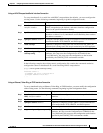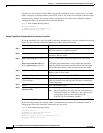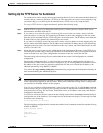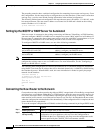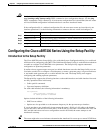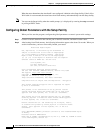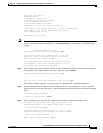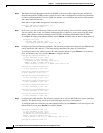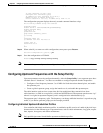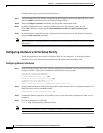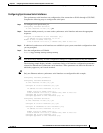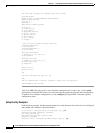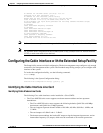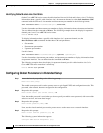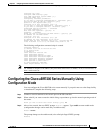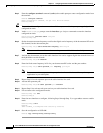
2-21
Cisco uBR7200 Series Universal Broadband Router Software Configuration Guide
OL-2239-03
Chapter2 Configuring the Cable Modem Termination System for the First Time
Configuring the Cisco uBR7200 Series Using the Setup Facility
Is this interface in use? [yes]:
Configure this interface? [yes]:
IP address for this interface [19.2.22.6]:
Number of bits in subnet field [8]:
Class A network is 19.0.0.0, 8 subnet bits; mask is /16
The configuration program displays the newly created command interface script:
The following command script was created:
hostname router
enable secret 5 $1$f0fc$A38P/KN/9yD3sEKSt6hKQ/
enable password betty
line vty 0 4
password wilma
snmp-server community public
!
ip routing
!
interface cable 5/0
ip address 19.2.22.5 255.255.0.0
router igrp 15
network 19.0.0.0
!
end
Step10 When asked if you want to use this configuration, enter yes or press Return.
Use this configuration? [yes/no]: yes
Step11 Save the configuration to NVRAM:
Router# copy running-config startup-config
Note You must always manually save the configuration settings to NVRAM whenever they are modified.
Configuring Upstream Frequencies with the Setup Facility
Upstream parameters must be configured manually. After the Setup facility is run, upstream ports have
a default state of “shutdown.” You have two methods to configure upstream channel frequencies:
• Configure a fixed frequency between 5 to 42MHz for North American channel plans, and enable
the upstream port.
• Create a global spectrum group, assign the interface to it, and enable the upstream port.
The cableinterface card receiver accepts time-division multiplexed burst transmissions from
cableinterfaces (or CMs in set-top boxes), which are DOCSIS-based. The upstream port becomes “up”
when it is assigned an upstream frequency and is configured to be administratively up.
The upstream port is frequency-agile. The frequency can change while the interface is up and carrying
traffic, if you define spectrum groups per the example provided.
Configuring Individual Upstream Modulation Profiles
You can define individual modulation profiles. A modulation profile consists of a table of physical layer
characteristics for the different types of upstream bursts such as initial maintenance, long grant, request
data, request, short grant, and station maintenance.
Note Only qualified personnel should define upstream modulation profiles.



